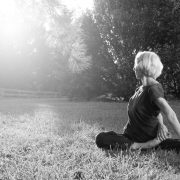Is the World going Mad?
On two occasions recently, I overheard this question raised during conversations before class. This was not an idle observation. It evoked a sense of helplessness and dread. I think we all felt this for a moment before it was time to ring the chimes and begin body and breath awareness.
We are immersed in media coverage of world events and it seems that there is no corner of the world so remote that the media has no access. We see and hear every natural and man-made disaster. Our viewing experience can be so intense that we feel involved. And, as citizens of planet earth, we are. But what are we to do? I suspect that this is now a universal concern: Is the world going mad and what can I do about it?
This past summer, following an afternoon meditation at a Buddhist monastery, one of the participants voiced a similar concern: “How can we, as individuals, maintain inner peace when there’s chaos and destruction in so many parts of the world?” The teacher thought for a moment and then suggested getting involved in organizations devoted to helping refugees or aiding countries ravaged by internal conflict. I believe the Buddhist teacher’s answer was wise up to a point. Taking action of any kind can be satisfying. But how do we stay centered?
As a mother I would first offer this advice: avoid large crowds and obey your survival instincts. As a Yoga teacher, I would remind you of a slogan from the nineteen-sixties: Be Here Now. Setting aside its hippie implications, please look to its deeper meaning. Be in the present moment. Let go of the past. Understand that the future is unknowable. What is here, now?
Let’s start with body awareness. Assuming you’re viewing a computer or some kind of mobile device, how is your body organized? Where do you sense contact with your chair? How are you arranging your legs? Can you scan through your body gradually, starting with your feet? When your awareness reaches your head, what do you sense about your jaw, your face? How would it feel to loosen the jaw, to soften your face, to release any tension in your scalp?
Next, pay attention to your breathing. Without trying to change anything, simply observe its rhythm. Breath comes in; breath goes out. Stay with the breath as it’s happening. You might sense the movement of breath in some areas of your body. Perhaps there are areas that soften as you follow the breath — softening the nose and throat, the ribcage, the abdomen. Be with the breath. Allow your mind to simply focus on the breath for a while. In these brief moments, your mind can set aside thinking and open to the breath. This practice calms and quiets your mind. We often find that resting the mind brings us clarity, a fresh perspective, an appreciation of the here and now. And this is all we have. This moment.
You are a valuable human being and you have much to offer the world because you come from a place of balance and harmony and peace. Namasté.









Leave a Reply
Want to join the discussion?Feel free to contribute!